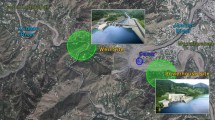Abstract
Typhoons and storms have often brought heavy rainfalls and induced floods that have frequently caused severe damage and loss of life in Taiwan. Our ability to predict sewer discharge and forecast floods in advance during storm seasons plays an important role in flood warning and flood hazard mitigation. In this paper, we develop an integrated model (TFMBPN) for forecasting sewer discharge that combines two traditional models: a transfer function model and a back propagation neural network. We evaluated the integrated model and the two traditional models by applying them to a sewer system of Taipei metropolis during three past typhoon events (NARI, SINLAKU, and NAKR). The performances of the models were evaluated by using predictions of a total of 6 h of sewer flow stages, and six different evaluation indices of the predictions. Finally, an overall performance index was determined to assess the overall performance of each model. Based on these evaluation indices, our analysis shows that TFMBNP yields accurate results that surpass the two traditional models. Thus, TFMBNP appears to be a promising tool for flood forecasting for the Taipei metropolis sewer system.






Similar content being viewed by others
References
Akaike H (1974) A new look at the statistical model identification. IEEE Trans Automat Control 19:716–723
Box GEP, Jenkins GM (1976) Time series analysis: forecasting and control, (rev. ed.). Holden-Day Inc, San Francisco, CA
Campolo M, Andreussi P, Soldati A (1999) River flood forecasting with a neural network model. Water Resour Res 35:1191–1197
Capodaglio AG (1994) Transfer function modelling of urban drainage systems and potential uses in real-time control applications. Water Sci Technol 29(1–2):409–417
Chakraborty K, Mehrotra K, Mohan CK, Ranka S (1992) Forecasting the behavior of multivariate time series using neural network. Neural Netw 5:961–970
Cybenko G (1989) Approximation by superposition of a sigmoidal functions. Math Control Signals Systems 2:303–314
Dai HC, Macheth C (1997) Effects of learning rate parameters on learning procedure and performance of a BPNN. Neural Netw 10(8):1505–1521
Dawson CW and Wilby R (1998) An artificial neural network approach to rainfall runoff modeling. Hydrol Sci J 43(1):47–66
Dickey DA, Fuller WA (1979) Distribution of the estimators for autoregressive time series with a unit root. J Amer Statist Assoc 74(366):427–431
Hagan MT, Demuth HB, Beale MH (1996) Neural network design. PWS Publishing, Boston, MA
Hassoun MH (1995) Fundamentals of artificial neural networks. MIT Press, Cambridge
Imrie CE, Durucan S, Korre A (2000) River flow prediction using artificial neural networks: generalization beyond the calibration range. J Hydrol 233:138–153
Karunanithi N, Grenney WJ, Whitley D, Bovee K (1994) Neural networks for river flow prediction. J Comput Civil Eng ASCE 8(2):301–320
Lachtermacher G, Fuller JD (1994) Backpropagation in hydrological time series forecasting. In: Stochastic and statistical methods in hydrology and environmental engineering. Kluwer Academic, Dordrecht
Ljung G, George B (1978) On a measure of lack of fit in time series models. Biometrica 65:297–303
Maier HR, Dandy GC (1997) Determine inputs for neural network models of multivariate time series. Microcomput Civil Eng, (12):353–368
Maier HR, Dandy GC (2000) Neural network for the prediction and forecasting of water resources variables: a review of modeling and applications. Environ Model Softw 15(1):101–124
Makridadis S, Wheelwright SC, McGee E (1983) Forecasting: methods and applications, 2nd edn. Wiley, New York, pp 532–548
Masters T (1993) Practical neural network recipes in C++. Academic, San Diego
Narendra KS, Parthasarathy K (1990) Identification and control of dynamical systems using neural networks. IEEE Trans Neural Netw 1:4–27
Novotny V, Zheng S (1989) Rainfall–runoff transfer function by ARMA modelling. ASCE J Hydrol Eng 115(10):1386–1400
Pack DJ (1977) Revealing time series interrelation. Decis Sci (8):377–402
Rajukar MP, Kothyari UC, Chaube UC (2004) Modelling of the daily rainfall–runoff relationship with artificial neural network. J Hydrol 285:96–113
Roger DB, Michael LK, Louis S (1998) Feed-forward artificial network model for forecasting rainfall run-off. Environmetrics 9:419–432
Schwarz G (1978) Estimating the dimension of a model. Ann Stat 6:461–464
Singh VP (1995) Computer models of watershed hydrology. Water Resource Publications, Canada, pp 783–808
Tawatchai T, Gautam MR (2000) Application of Tank, NAM, ARMA and neural network models to flood forecasting. Hydrol Process 14:2473–2487
Warner B and Misra M (1996) Understanding neural network as statistical tools. Amer Statist 50(4):284–293
Widrow B, Hoff ME (1960) Adaptive switching circuits. In: IRE WESTCON Connection Record, vol 4, pp 96–104
Yeh IC (1999) Application and practice of neural network models. Scholar Books Co., Taiwan (Chinese version)
Zealand C, Burn DH, Simonovic SP (1999) Short term streamflow forecasting using artificial neural networks. J Hydrol 214:32–48
Zheng S, Novotny V (1991) Stochastic modeling of combined sewer flows. Water Sci Technol 24(6):35–40
Acknowledgments
The authors wish to sincerely thank the anonymous reviewers whose comments greatly improved the quality of this paper. Many thanks are extended to Mr. Hsu, Wen-Chun and Mr. Pan, Kwan-Long, the governors of Taipei Metropolis, for providing valuable data sets and their comments and suggestions for this work.
Author information
Authors and Affiliations
Corresponding author
Additional information
For publication in Stochastic Environmental Research and Risk Analysis.
Rights and permissions
About this article
Cite this article
Lu, CC., Chen, CH., Yeh, TC.J. et al. Integration of transfer function model and back propagation neural network for forecasting storm sewer flow in Taipei metropolis. Stoch Environ Res Ris Assess 20, 6–22 (2006). https://doi.org/10.1007/s00477-005-0243-7
Published:
Issue Date:
DOI: https://doi.org/10.1007/s00477-005-0243-7




